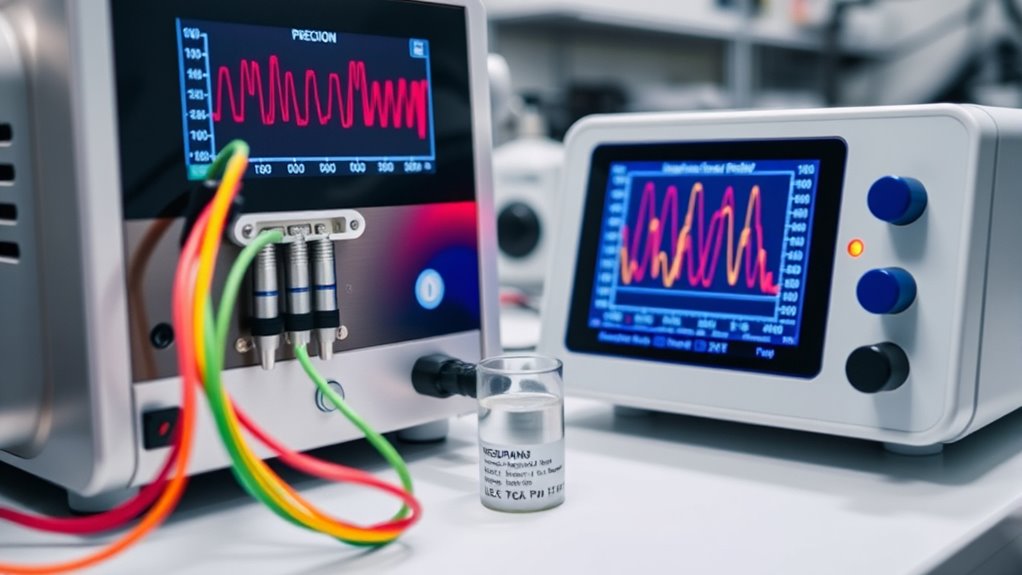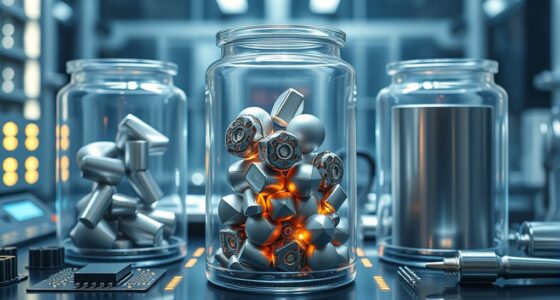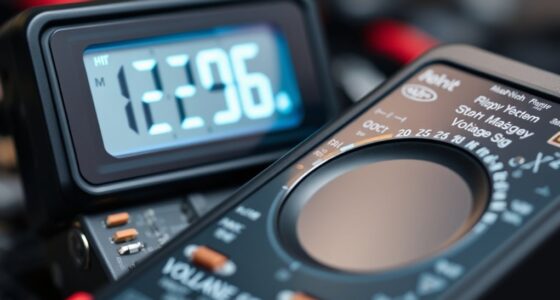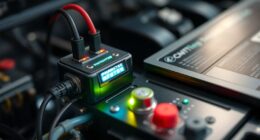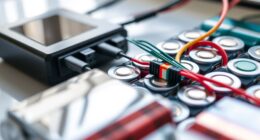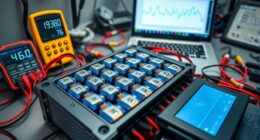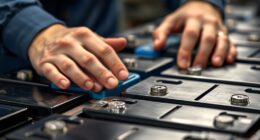Impedance spectroscopy is a vital technique that helps you analyze a material’s electrical properties over a wide frequency range. By applying an AC signal and measuring responses, you gain insights into conductivity, dielectric behavior, and charge transfer processes. It’s essential for designing better electronics, batteries, and sensors. Mastering this method allows you to troubleshoot and optimize systems effectively, and exploring further will give you the tools to harness its full potential.
Key Takeaways
- Impedance spectroscopy analyzes material electrical properties over a wide frequency range, revealing conductivity, dielectric behavior, and charge transfer.
- It requires specialized equipment like impedance analyzers and precise probe setups to ensure accurate measurements.
- Proper environmental control and electrode configuration are essential for reliable and reproducible data.
- Data visualization through Nyquist and Bode plots helps interpret complex impedance behaviors effectively.
- Mastering this technique enhances material assessment, troubleshooting, and design of electronic components and sensors.
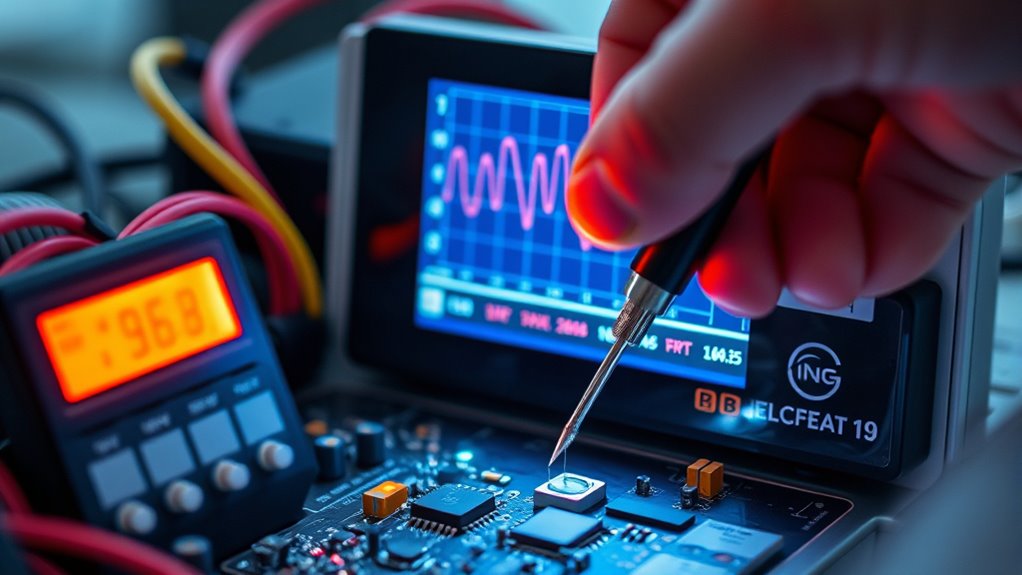
Impedance spectroscopy is a powerful technique used to analyze the electrical properties of materials and systems across a range of frequencies. As an engineer, understanding how this method works can substantially enhance your ability to assess material properties and troubleshoot complex systems. When you perform impedance spectroscopy, you’re fundamentally applying an AC signal to your sample and measuring how the material responds at various frequencies. This approach reveals valuable insights into the material’s behavior, such as conductivity, dielectric constant, and charge transfer characteristics. These properties are critical in designing better electronic components, batteries, sensors, and even biological systems.
Your measurement techniques are central to obtaining accurate and meaningful data. Typically, you’ll use an impedance analyzer or a potentiostat with impedance capabilities, connecting your sample with precise probes to minimize noise and errors. It’s important to control environmental conditions like temperature and humidity because they influence the electrical response of materials. During the measurement, you sweep through a frequency range—often from millihertz to megahertz—recording the impedance magnitude and phase angle at each point. This data forms the basis for creating Nyquist and Bode plots, which visually represent the complex impedance behavior and help you interpret the underlying material properties.
The key to effective impedance spectroscopy lies in selecting appropriate measurement techniques. For instance, you need to decide whether to perform a single-frequency or broadband measurement. Single-frequency tests can quickly give you specific information about particular properties, but broadband measurements provide an all-encompassing picture of how your material behaves across a spectrum. Additionally, choosing the right electrode configuration, such as two-electrode or four-electrode setups, impacts your data’s accuracy, especially when dealing with materials that have high resistance or require precise current measurements. Calibration is also vital; regularly calibrating your instruments ensures that your measurements remain dependable over time. Moreover, understanding the trends in grocery retail hours can help ensure your lab equipment is available and functioning during optimal time frames to maximize efficiency.
Frequently Asked Questions
How Does Temperature Affect Impedance Measurements?
Temperature effects can considerably impact your impedance measurements, often leading to inaccuracies if not properly managed. As temperature rises, it can alter the electrical properties of materials, changing their impedance. This variation affects measurement accuracy, making it essential to control or compensate for temperature fluctuations during testing. By maintaining a stable temperature environment or applying correction factors, you ensure more reliable, precise impedance data for your engineering applications.
What Are Common Sources of Measurement Error?
While it’s easy to overlook, measurement errors like electrode polarization and parasitic capacitance often whisper behind the scenes, subtly influencing your results. Electrode polarization can distort low-frequency data, while parasitic capacitance introduces unwanted noise. You should guarantee proper calibration, clean contacts, and stable environmental conditions to minimize these issues. Recognizing these common sources helps you improve accuracy and reliability, ensuring your impedance measurements truly reflect the material’s properties.
Can Impedance Spectroscopy Be Used for Biological Samples?
You can definitely use impedance spectroscopy for biological samples, especially in bioimpedance analysis and cellular characterization. It helps you measure electrical properties of tissues and cells, giving insights into health, hydration, and tissue structure. Just keep in mind that biological samples often introduce variability and noise, so careful calibration and proper electrode contact are essential to obtain accurate, reliable data.
What Are the Limitations of Impedance Spectroscopy?
Ever wondered about the limits of impedance spectroscopy? You might face challenges with sample preparation, as precise and consistent samples are vital for reliable results. Data interpretation can also be tricky, especially with complex materials or biological samples, where overlapping responses occur. These limitations can affect accuracy and repeatability, so you need to carefully optimize your setup and analyze data thoroughly to guarantee meaningful insights from your measurements.
How Do I Select the Right Frequency Range?
When selecting the right frequency range, consider your sample properties like size, conductivity, and expected response. Start with a broad spectrum to identify key features, then narrow it down to focus on relevant frequencies. Adjust based on your data, ensuring you capture the full impedance behavior. This approach helps you optimize measurements, avoid noise, and obtain accurate insights into your sample’s electrical characteristics.
Conclusion
Impedance spectroscopy is your secret weapon, a guiding compass through the complex maze of materials and devices. With each measurement, you reveal hidden stories buried deep within, revealing their true nature like a detective uncovering clues. Embrace this technique, and you’ll wield a powerful tool that transforms chaos into clarity. Master it, and watch your engineering projects dance to a rhythm of precision, innovation, and endless possibility.

